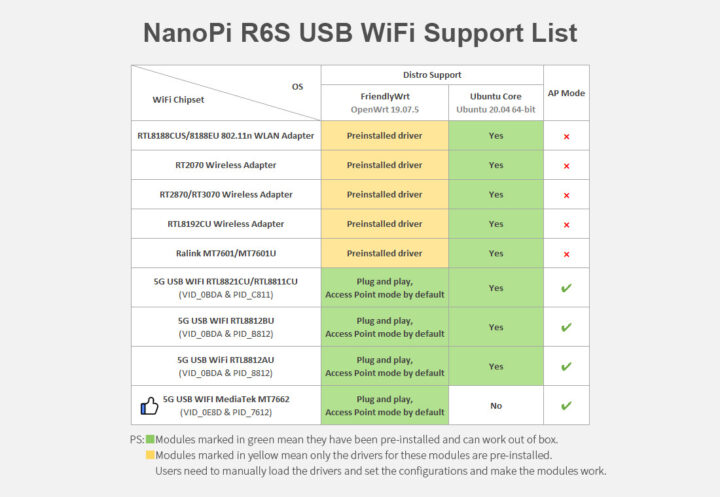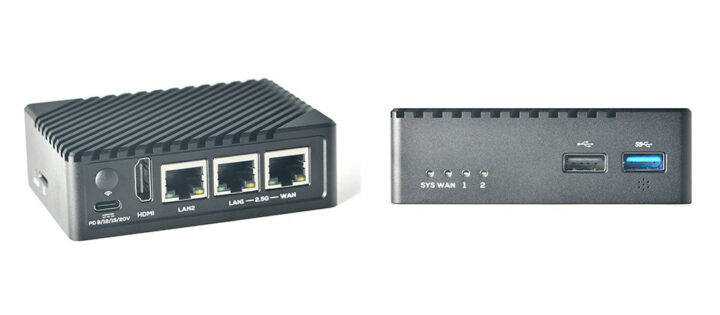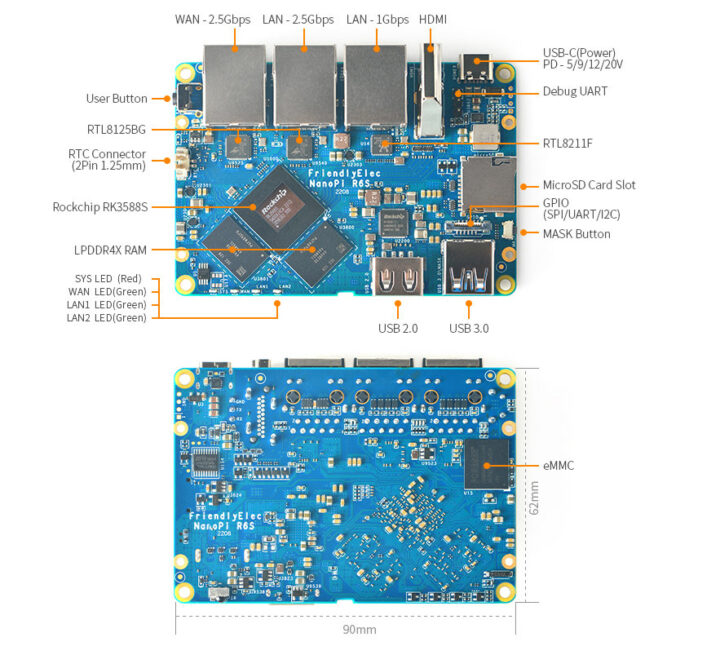FriendlyELEC has launched its sixth generation router with the NanoPi R6S equipped with a Rockchip RK3588S processor, two 2.5GbE ports, one Gigabit Ethernet port, and two USB interfaces.
But the device will not exactly be limited to router functions as it comes with 8GB RAM, a 32GB eMMC flash, and an HDMI 2.1 port that support up to 8Kp60 video output, not to mention 8K video decoding capability and the integrated 6 TOPS NPU for AI workloads.
- SoC – Rockchip RK3588S octa-core processor with:
- CPU – 4x Cortex-A76 cores @ up to 2.4 GHz, four Cortex-A55 cores @ 1.8 GHz
- GPU – Arm Mali-G610 MP4 quad-core GPU with OpenGL ES3.2 / OpenCL 2.2 / Vulkan1.1 support
- VPU – 8Kp60 H.265/VP9/AVS2 video decoder, 8Kp30 H.264 decoder, 4Kp60 AV1 decoder, 8Kp30 H.265/H.264 video encoder
- AI accelerator – 6 TOPS NPU
- System Memory – 8GB LPDDR4X @ 2133 MHz
- Storage
- 32 GB eMMC flash
- Optional SPI flash for network boot
- MicroSD card socket
- Video Output – 1x HDMI 2.1 port up to 8Kp60, or 4Kp120
- Networking
- 2x 2.5GbE RJ45 ports (via 2x Realtek RTL8125BG PCIe controllers) tested up to 2.35 Gbps (Rx) and 2.35 Gbps (Tx)
- 1x Gigabit Ethernet RJ45 port (via Realtek RTL8211F) tested up to 941 Mbps (Tx and Rx)
- USB – 1x USB 3.0 port, 1x USB 2.0 port
- Expansion – 12-pin 0.5mm pitch FPC connector with up to 1x SPI, 3x UART, 1x I2C, 8x GPIO
- Debugging – 3-pin UART header
- Misc
- Mask key for eMMC flash update
- RTC connector for HYM8563TS real-time clock
- 5V fan header
- 1x user button
- 4x user LEDs for system and Ethernet ports
- IR receiver
- Power Supply – 5V/9V/12V USB Type-C port (USB PD support)
- Dimensions – PCB: 90 x 62 mm; enclosure: 96.5 x 68 x 30 mm
- Weight – TBD
- Temperature Range – 0 to 70
The NanoPi R6S will be much more powerful than the Rockchip RK3568-based NanoPi R5S mini router introduced last year, but some features are been removed such as the M.2 socket for an NVMe SSD, the 16-pin GPIO header on the SBC is gone, and the company also had to replace one of the USB 3.0 ports with a USB 2.0 port. That’s just because RK3588S has fewer interfaces than the RK3568 SoC.
2.5 Gbps Ethernet appears to have improved, while the R5S could receive data at up to 2.35 Gbps, it would only transmit up to 1.8 Gbps, and the R6S delivers 2.35 Gbps in both directions. As usual, there’s no WiFi because the company expects customers to add a USB dongle if needed. FriendlyELEC offers three OS images for the board/router, with FriendlyWrt based on the latest OpenWrt 22.03, FriendlyWrt with Docker, and FriendlyCore Lite based on Ubuntu 20.04 with all images relying on the Linux 5.10 LTS kernel. More details can be found in the Wiki.

FriendlyELEC contacted me last week about sending NanoPi R6S samples, so expect a review soon. The NanoPi R6S is available as either a bare SBC for $119 or a router with a metal enclosure for $139.
Via Liliputing

Jean-Luc started CNX Software in 2010 as a part-time endeavor, before quitting his job as a software engineering manager, and starting to write daily news, and reviews full time later in 2011.
Support CNX Software! Donate via cryptocurrencies, become a Patron on Patreon, or purchase goods on Amazon or Aliexpress






